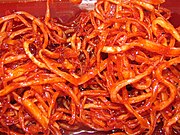Do you like dried squid? It's one of my favorites. It's like eating an exotic bubble gum, but you could actually swallow or eat it! My husband hates the smell of dried squid. I guess eating dried squid is an Asian thing? In other western countries, in Mid East contries, they hate the smell of dried squid when you're cooking it. Neighbors could actually call and complain to the police when you fry dried squid, dried fish. I am not into dried fish (I have allergies when I eat dried fish) but dried squid is - yeah baby!
Some like it dried and shredded, calling it dried shredded squid. Some call it cuttle fish instead of squid.
do you know that dried squid is so rich in zinc? Here's the nutritional information of dried squid: How do you process dried squid? Below is from Wikipedia:
Preparation
Northern Pacific Squid is separated into different parts and skinned, cooked at 65-80C for 3-5 minutes, cooled, grated and seasoned at a temperature below 20C for more than 4 hours. Sugar, salt, sorbitol, sweetener, and organic acid is added.[2] They are then dried at 40-45C for 12-20 hours until it reaches a moisture level of 40%. It is then aged in a cold room for 2 weeks or longer, then dried at a higher temperature of 110-120C for 3-5 minutes.[2] It is then machine-shredded and seasoned for a second time, dried again to a reduced moisture level of 25-27%. At this phase the color is yellow or brownish. The amino acids on the squid are revealed by the increase in brown color over prolonged storage time. Vacuum packaging or nitrogen-filled packaging also increase browning. Consumers generally do not want excessive browning.[2]
Some claim that dried squid is not healthy, as some would put arsenic on it. In the Philippines, fresh squid are simply dried in hot sun and packaged - no chemicals at all.
| Nutrition Facts | ||||||||||||||||||||||||||||||||||||||||||||||||||||||||||||||||||||||||||||||||
| Amount Per 1 oz, boneless | ||||||||||||||||||||||||||||||||||||||||||||||||||||||||||||||||||||||||||||||||
| Calories 98.87 Calories from Fat 13.35 | ||||||||||||||||||||||||||||||||||||||||||||||||||||||||||||||||||||||||||||||||
| ||||||||||||||||||||||||||||||||||||||||||||||||||||||||||||||||||||||||||||||||
| ||||||||||||||||||||||||||||||||||||||||||||||||||||||||||||||||||||||||||||||||
| *Percent Daily Values are based on a 2,000 calorie diet. Your daily values may be higher or lower depending on your calorie needs. | ||||||||||||||||||||||||||||||||||||||||||||||||||||||||||||||||||||||||||||||||




















No comments:
Post a Comment
I thrive on comments, thanks for leaving a comment. I will visit your blog as well :)